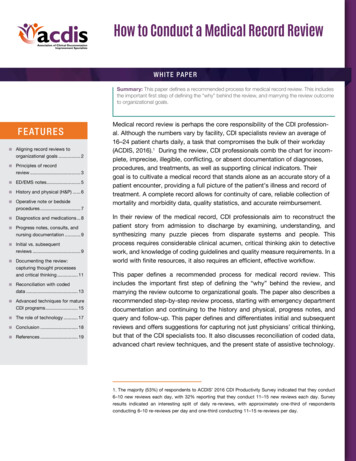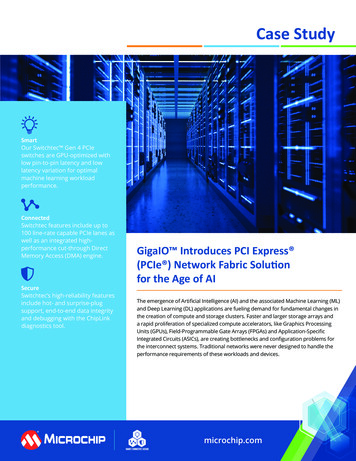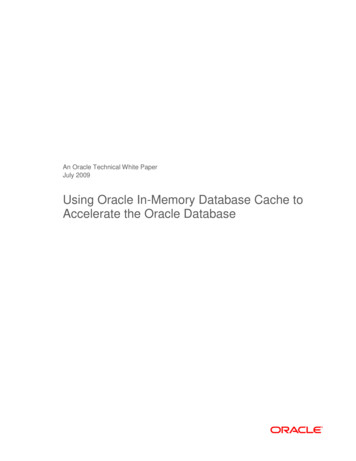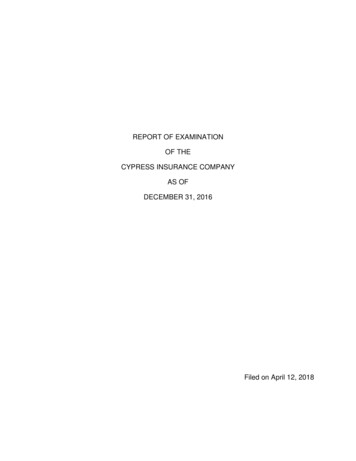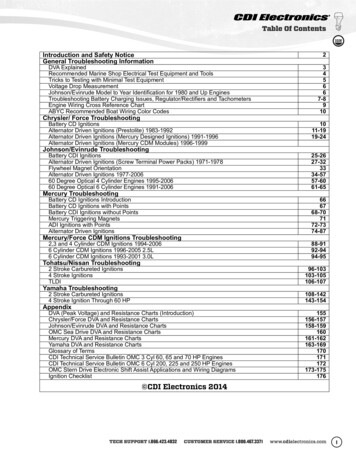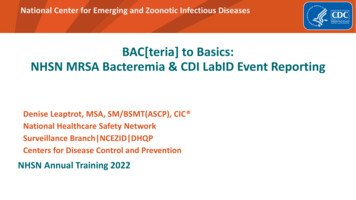
Transcription
PRIVACY IMPACT ASSESSMENTConsularOne Database Infrastructure (CA CDI)1. Contact InformationA/GIS Deputy Assistant SecretaryBureau of AdministrationGlobal Information Services2. System Information(a) Name of system: ConsularOne Database Infrastructure(b) Bureau: Consular Affairs (CA)(c) System acronym: CA CDI(d) iMatrix Asset ID Number: 253145(e) Reason for performing PIA: New system Significant modification to an existing system To update existing PIA for a triennial security reauthorization(f) Explanation of modification (if applicable):3. General Information(a) Does the system have a completed and submitted Security Categorization Form(SCF)? Yes No - Contact IRM/IA at IASolutionCenter@state.gov for assistance.(b) What is the security Assessment and Authorization (A&A) status of the system?The initial Assessment and Authorization process is underway and CA CDI is expectedto receive an Authorization-To-Operate by Summer 2018.(c) Describe the purpose of the system:ConsularOne is a major system that supports modernization efforts intended to replaceoutdated legacy applications. This modernized system moves paper-based services to beprocessed electronically (online), allowing citizens and non-citizens to request servicesfrom Consular Affairs (CA). Using a Service Oriented Architecture (SOA), the systemdecouples service capability to improve performance, scalability, and speed-to-market.
The purpose of CA CDI is to store much of the data related to ongoing ConsularOneoperations. CA CDI stores data associated with processing of visa, passport, and citizenservices, including pictures, fingerprints, case documents, and photos. In addition, CACDI stores administrative files related to backups and logs. The CA CDI system stores alldata entered into the CA ConsularOne Application and Data (CAD) system. CA CADprovides the interface to the end user requesting services. Data processed by CA CAD isstored in CA CDI. All data is transmitted database-to-database.(d) Describe the personally identifiable information (PII) that the system collects, uses,maintains, or disseminates:The PII collected by the system is based on information requirements supportingConsularOne modernization effort.General PII categories include: NamesBirthdatesFinancial account numbersSocial Security NumbersPhone number(s)Home AddressE-mail address(es) of individualsImages or biometric identifiersMedical informationFinancial informationLegal informationFamily informationEducational information(e) What are the specific legal authorities and/or agreements that allow the informationto be collected? 5 U.S.C. 552a, Privacy Act of 1974, as amended8 U.S.C. 1101 et seq., Immigration and Nationality Act of 1952, as amended,including 8 U.S.C. 1104 Powers and duties of Secretary of State and 8 U.S.C. 1185,Travel Documentation of Aliens and Citizens;22 U.S.C 2651a (Organization of Department of State)22 U.S.C. 3927 (Chief of Mission)22 U.S.C. 3904 (Functions of the Foreign Service, including protection of U.S.citizens in foreign countries under the Vienna Convention on Consular Relations andproviding assistance to other agencies);Page 2
8 U.S.C. 1401, 1408, and 1409 (Citizens and nationals of the United States by birth);22 U.S.C. 1731 (Protection of naturalized U.S. citizens in foreign countries);22 U.S.C. 211a et seq. (Passport application and issuance);22 U.S.C. 2714a.(f) (Revocation or Denial of Passport in Case of Individual withoutSocial Security Number)22 U.S.C. 2705 (U.S. Passports and Consular Reports of Birth Abroad);8 U.S.C. 1501–1504 (Adjudication of possible loss of nationality and cancellation ofU.S. passports and CRBAs);22 U.S.C. 2671(b)(2)(A)–(B) and (d) (Evacuation assistance and repatriation loansfor destitute U.S. citizens abroad);22 U.S.C. 2670(j) (Provision of emergency medical, dietary and other assistance);22 U.S.C. 2151n–1 (Assistance to arrested citizens) (Repealed, but applicable to pastrecords);42 U.S.C. 1973ff–1973ff–6 (Overseas absentee voting);42 U.S.C. 402 (Social Security benefits payments);Sec. 599C of Public Law 101–513, 104 Stat. 1979, as amended (Claims to benefits byvirtue of hostage status) (Benefits ended, but applicable to past records);50 U.S.C. App. 453, 454, Presidential Proclamation No. 4771, July 2, 1980 asamended by Presidential Proclamation 7275, February 22, 2000 (Selective Serviceregistration);22 U.S.C. 5501–5513 (Aviation disaster and security assistance abroad; mandatoryavailability of airline passengers manifest);22 U.S.C. 4195, 4196 (Official notification of death of U.S. citizens in foreigncountries; transmission of inventory of effects) (22 U.S.C. 4195 repealed, butapplicable to past records);22 U.S.C. 2715b (Notification of next of kin of death of U.S. citizens in foreigncountries);22 U.S.C. 4197 (Assistance with disposition of estates of U.S. citizens upon death ina foreign country);22 U.S.C. 4193, 4194; 22 U.S.C. 4205–4207; 46 U.S.C. 10318 (Merchant seamenprotection and relief);22 U.S.C. 4193 (Receiving protests or declarations of U.S. citizen passengers,merchants in foreign ports);46 U.S.C. 10701–10705 (Responsibility for deceased seamen and their effects);22 U.S.C. 2715a (Responsibility to inform victims and their families regarding crimesagainst U.S. citizens abroad);22 U.S.C. 4215, 4221 (Administration of oaths, affidavits, and other notarial acts);26 U.S.C. 6039E (Information Concerning Resident Status)28 U.S.C. 1740, 1741 (Authentication of documents);Page 3
28 U.S.C. 1781–1785 (Judicial Assistance to U.S. and foreign courts and litigants);42 U.S.C. 14901–14954(Implementing legislation for the Convention on Protectionof Children and Co-operation in Respect of Intercountry Adoption (done at TheHague on May 29, 1993);Intercountry Adoption Act of 2000, (Assistance with intercountry adoptions under theHague Intercountry Adoption Convention, maintenance of related records);22 U.S.C. 9001–9011, International Child Abduction Remedies Act (Assistance toapplicants in the location and return of children wrongfully removed or retained or forsecuring effective exercise of rights of access;22 U.S.C. 9101, 9111–9114, 9121–9125, 9141, International Child AbductionPrevention and Return Act of 2014 (Reporting requirements, prevention measures,and other assistance on international parental child abduction cases);22 U.S.C. 4802 (overseas evacuations);Executive Order 11295, of August 5, 1966, 31 FR 10603 (Authority of the Secretaryof State in granting and issuing U.S. passports)22 C.F.R. Part 22 (Schedule of Fees for Consular Services –Department of State andForeign Service)22 C.F.R. Parts 50, 51 and 52 (Nationality Procedures and Passports)22 C.F.R. Part 71 (Protection and Welfare of Citizens and Their Property)22 C.F.R. Part 72 (Deaths and Estates)22 C.F.R. Part 92 (Notarial and Related Services)22 C.F.R. Part 93 (Service on Foreign State)22 C.F.R. Parts 96 -99 (Intercountry Adoptions)8 U.S.C. 1104 (Powers and Duties of the Secretary of State)8 U.S.C. 1185 (2010) (Travel Control of Citizens)8 U.S.C. 1401-1503 (2010) (Acquisition and Loss of U.S. Citizenship or U.S.Nationality Use of U.S. Passport)18 U.S.C. 911, 1001, 1541-1546 (Crimes and Criminal Procedure)22 U.S.C. 211a-218, 2651a, 2705 (2010)22 U.S.C. 2651a (Organization of Department of State), Executive Order 11295,August 5, 1966, 31 FR 10603; (Authority of the Secretary of State in granting andissuing U.S. passports)22 U.S.C. § 3927 (Chief of Mission)22 C.F.R. Parts 50 and 51 (Nationality Procedures and Passports)26 U.S.C. 6039E (Information Concerning Residence Status(f) Is the information searchable by a personal identifier (e.g., name or Social Securitynumber)? Yes, provide:Page 4
-SORN Name and Number:SORN publication date (found under the Volume Number and above the PublicNotice Number on the published SORN):State-05 Overseas Citizens Services Records and Other Overseas Records,September 8, 2016State-26 Passport Records, March 24, 2015 No, explain how the information is retrieved without a personal identifier.(g) Does the existing SORN need to be amended to reflect the inclusion of this new orsignificantly modified system? Yes NoIf yes, please notify the Privacy Division at Privacy@state.gov.(h) Is there a records retention schedule submitted to or approved by the NationalArchives and Records Administration (NARA) for this system? Yes No(If uncertain about this question, please contact the Department’s Records Officer atrecords@state.gov .)If yes provide: (obtain info from d.asp)(If the list is long – name only the top level and indicate length of time as variable basedon document and detailed info is at the link)- Schedule number (e.g., (XX-587-XX-XXX)):- Length of time the information is retained in the system:- Type of information retained in the system:A-15-001-01Consular Services Policy FileDescription:Consists of correspondence and reports which document thedevelopment and implementation of policies, procedures, agreements,regulations, and legislation pertaining to the provision of consularservices. Excludes material regarding routine operational andadministrative activities and material concerning matters for whichother offices have primary responsibility.Disposition:Permanent. Retire to the RSC when 5 years old. Transfer to the NationalArchives when 15 years old.Page 5
DispAuthNo:NC1-059-77-28, item 1A-15-001-02American Citizens Services (ACS) systemDescription:The American Citizens Services (ACS) system is an electronic casemanagement application designed to track, monitor, and report onservices provided to U.S. citizens traveling or living abroad. ACSsupports domestic consular operations and consular activities atoverseas Posts.ACS records include case level data on the following types of citizenservices: arrest cases; citizenship issues; death notifications; financialassistance cases; loss of nationality cases; lost and stolen passports;property cases; citizen registrations; and welfare and whereabouts cases.Record level data includes biographic information, case information,and case activity log.Disposition:TEMPORARY. Cut off when case closed/abandoned. Destroy 3 yearsafter cut off or when no longer needed, whichever is later.NOTE: ACS case records are replicated to the Consular ConsolidatedDatabase each day for long-term recordkeeping.(Supersedes NARA Job No. NI-059-96-30, Item 1 and NARA Job No.NI-084-96-4, Item 1)DispAuthNo:N1-059-09-40, item 1A-15-002-01General Policy Files (Abduction and Adoption) - Arrange bysubjectDescription:Memorandums, correspondence, telegrams, court decisions, briefingpapers, and other material relating to matters handled by the Office ofChildren’s Affairs.Disposition:Permanent. Cut off files when 10 years old and transfer to RSC fortransfer to WNRC. Transfer to the National Archives when 25 yearsold.Page 6
DispAuthNo:N1-059-97-14, item 1A-15-002-02Child Custody/Abduction Case FilesDescription:Cases reflect applications filed for the return of children abducted tocountries that are party and not party to the Hague AbductionConvention. Included are requests for assistance in locating childrentaken by the other parent, legal proceedings, and information onavailable courses of action, monitoring the welfare of a child,information on child custody laws and procedures in the host country,and related correspondence.Disposition:Transfer to the RSC after the case is deemed closed and no action hastaken place for 1 year for transfer to the WNRC. Destroy when 15 yearsold.DispAuthNo:N1-059-97-14, item 2A-15-002-03Adoptions Tracking Service (ATS)Description:ATS is an electronic information system designed to track, monitor, andreport on all adoption cases involving emigration from or immigrationto the U.S as mandated by the Intercountry Adoption Act of 2000(IAA). Activities include monitoring organizations that provide intercountry adoption services, responding to adoption-related inquiries fromthe public and other interested stakeholders, reporting to Congressionalrepresentatives on inter-country adoptions involving U.S. citizens,producing mandatory annual reports to Congress, and communicatingwith all inter-country adoption stakeholders.ATS supports the U.S. Central Authority for Inter-country Adoptions(USCA), which has inter-country adoption-related responsibilitiesinvolving U.S. citizens. The IAA designated the Department of State asU.S. Central Authority for Inter-country Adoptions under the HagueAdoption Convention. The day-to-day work of the U.S. CentralAuthority is the responsibility of the Bureau of Consular Affairs,Directorate of Overseas Citizens Services, Office of Children’s Issues(CA/OCS/CI).Page 7
ATS records include the following types of information: uniqueidentifier, case status and tracking information, application information,adoptive parent information, child information, Hague Conventiondocumentation, inquiry and complaint information, and adoption agencyinformation.Disposition:TEMPORARY. Cut off at end of calendar year when adoption casecloses. Destroy 75 years after adoption case closed.DispAuthNo:N1-059-09-09, item 1A-13-00101a(1)Passport Case Files - Passport and Citizenship Case Files, 1925-1970.Description:a. Case files containing one or more of the following types of records: passportapplications; Reports of Birth of American Citizens Abroad; Certificates ofWitness to Marriage; Applications for Amendment or Extension of Passport;Certificates of Loss of Nationality; and other supporting forms, documents andcorrespondence pertaining to each case.(1) Reports of Birth of American Citizens Abroad, Certificates of Witness toMarriage, Certificates of Loss of Nationality, and Oaths of Repatriation.Disposition:Permanent. Transfer to the National Archives when 50 years old.DispAuthNo:NC1-059-79-12, item 2a4. Characterization of the Information(a) What entities below are the original sources of the information in the system?Please check all that apply. Members of the Public (are US citizens or aliens lawfully admitted for permanentresidence) U.S. Government/Federal employees or Contractor employees Other (are not U.S. Citizens or aliens lawfully admitted for permanent residence)(b) If the system contains Social Security Numbers (SSNs), is the collection necessary? Yes No- If yes, under what authorization?Page 8
Executive Order 13478, November 18, 2008.(c) How is the information collected?Information is collected from within the CA CAD system boundary. Users (GeneralPublic) do not have access to CA CDI systems. All data is transmitted system-to-systemonly. The purpose of CA CDI is to store much of the data related to ongoingConsularOne operations.(d) Where is the information housed? Department-owned equipment FEDRAMP-certified cloud Other Federal agency equipment or cloud Other- If you did not select “Department-owned equipment,” please specify.(e) What process is used to determine if the information is accurate?As noted above, no data is entered into CA CDI directly. All data in CA CDI is from theCA CAD system as entered by the requestor of service. Accuracy is verified at the pointof collection by the CA CAD system which then shares the information with CA CDI.(f) Is the information current? If so, what steps or procedures are taken to ensure itremains current?As noted above, no data is entered into CA CDI directly. The information is current andverified at the point of collection by the CA CAD system which then shares theinformation with CA CDI.If corrections are needed to information, individuals can make changes via the system oforigin (CA CAD).(g) Does the system use information from commercial sources? Is the informationpublicly available?No, the system does not use commercial or publicly available information.(h) Is notice provided to the individual prior to the collection of his or her information?This is not applicable because no data is entered into CA CDI directly. The notice isprovided at the point of collection for the CA CAD system, in which information isentered. All data contained in the CA CDI system is from the CA CAD system.(i) Do individuals have the opportunity to decline to provide the information or toconsent to particular uses of the information? Yes NoPage 9
- If yes, how do individuals grant consent?No data is entered into CA CDI directly. As noted above, all data contained in the CACDI system is from the CA CAD system. Individuals grant consent via the CA CADsystem at the point of collection when applying for services.(j) How did privacy concerns influence the determination of what information wouldbe collected by the system?As noted above, all data contained in the CA CDI system is from the CA CAD system.There is no information collected by CA CDI. CDI provides the common technicalinfrastructure supporting information across systems’ storage devices to support consularservices operations. The PII items listed in paragraph 3(d) are the minimum necessary tofacilitate the administering and delivery of consular services.5. Use of information.(a) What is/are the intended use(s) for the information?The intended use of the information is to support the electronic facilitation of ongoingConsularOne operations.(b) Is the use of the information relevant to the purpose for which the system wasdesigned or for which it is being designed?Yes. The PII is used according to the purpose of storing and maintaining PII to supportprocessing of Consular One services regarding visa, passport, citizen services, pictures,fingerprints, case documents, and photos.(c) Does the system analyze the information stored in it? Yes NoIf yes:(1) What types of methods are used to analyze the information?The system does not analyze the information; CA CDI only stores information.(2) Does the analysis result in new information?Not applicable, as per above.(3) Will the new information be placed in the individual’s record? Yes No(4) With the new information, will the Department be able to make newdeterminations about the individual that would not have been possiblewithout it? Yes No6. Sharing of InformationPage 10
(a) With whom will the information be shared internally and/or externally? Pleaseidentify the recipients of the information.External Sharing: N/AInternal Sharing:Information is shared among the Consular One databases.(b) What information will be shared?PII listed in 3d of this PIA is shared between the Consular One databases.(c) What is the purpose for sharing the information?To provide and validate information to execute Consular One services.(d) The information to be shared is transmitted or disclosed by what methods?Any information shared with the CDI shall support traffic over Secure Socket Layer(SSL) or Transport Layer Security (TLS). It can support both protocols.(e) What safeguards are in place for each internal or external sharing arrangement?Internal sharing of PII is database to database with the CAD and Consular One databases.External sharing of CDI information is via the CAD system. CDI does not interface withexternal systems. Communications will be secured using Secure Socket Layer (SSL) andTransport Layer Security (TLS) for the internal sharing of information.(f) What privacy concerns were identified regarding the sharing of the information?How were these concerns addressed?Privacy concerns regarding the sharing of information focus on two primary sources ofrisk:a. Accidental disclosure of information to non-authorized partiesb. Deliberate disclosure/theft of information regardless whether the motivation wasmonetary, personal or other.Accidental disclosure is usually due to inadequate document control (hard copy orelectronic), inadequate PII and security training, or insufficient knowledge of roles,authorization and need-to-know policies. In addition, social engineering, phishing, andfirewall breaches can also represent a risk of accidental disclosure of information.These risks for accidental and deliberate disclosures are mitigated using a multi-facetedapproach to security:- Frequent security training for all personnel regarding information security,including the safe handling and storage of PII, “Sensitive but Unclassified”, andall higher levels of classification, and signing a user agreement.Page 11
-Strict access control based on roles and responsibilities, authorization and needto-know.-System authorization and accreditation process along with continuous monitoringRisk Management Framework (RMF). Security controls are implemented formanagement, operational, and technical functions regarding separation of duties,least privilege, auditing, and personnel account management.7. Redress and Notification(a) What procedures allow individuals to gain access to their information?For CA CDI, this is not applicable because no data is entered into CA CDI directly. Asnoted above, all data stored in CA CDI is from CA CAD. Individual users do not haveaccess to the system. If corrections are needed to information, individuals can makechanges via the system of origin (CA CAD).(b) Are procedures in place to allow an individual to correct inaccurate or erroneousinformation? Yes NoAs noted above, all data stored in CA CDI is from the CAD system. Individual users donot have access to the CDI system. Nor is data collected from applicants by the CDIsystem. If corrections are needed to information, individuals can make changes via thesystem of origin (CA CAD).If no, explain why not.(c) By what means are individuals notified of the procedures to correct theirinformation?CDI does not collect information from individuals. The information maintained in CDI isfrom the CAD system. Procedures are provided at the point of collection in CAD to correctrecords: The STATE-26 Passport Records SORN and STATE-05, Overseas Citizens ServicesRecords and Other Overseas Records SORN. The system of origin where services are being requested in the form of a privacy actstatement. Link to the privacy policy on the Department of State websitePage 12
Each method contains information on how to amend records and who/what office to getin touch with as well as providing contact information.8. Security Controls(a) How is the information in the system secured?CA CDI is secured within the Department of State databases that Data Engineering andData management (DEDM) manages in the Enterprise Server Operations Center(ESOC) West where risk factors are mitigated through the use of defense in-depth layersof security including management, operational and technical security controls, auditing,firewalls, physical security, and continuous monitoring.The information is further secured by limiting internal access to authorized Departmentof State users, including cleared contractors who have a justified need for the informationin order to perform official duties. Access to the system is secured as follows: Alladministrative accounts for the system must be approved by the both Government TaskManager (GTM) and Consular Affairs Information Systems Security Officer (CA ISSO).CA Systems are configured according the State Department Security ConfigurationGuides to optimize security while still providing functionality. Applicable NationalInstitute for Science and Technology, NIST Special Publication 800-53 and privacyoverlays of management, operational, and technical controls are in place and are tested aspart of the continuous monitoring program. Vulnerabilities noted during testing arereported appropriately.(b) Describe the procedures established to limit access to only those individuals whohave an “official” need to access the information in their work capacity.Internal/OpenNet users:To access the system, persons must be authorized users of the Department of State’sunclassified network OpenNet, which requires a background investigation and anapplication approved by the supervisor. Each authorized user must sign the user accessagreement/rules of behavior before being given a user account. Authorized users havebeen issued a Personal Identity Verification/Common Access Card and PersonalIdentification Number (PIV/CAC and PIN) which meets the dual authenticationrequirement for federal system access and is required for logon.Access to the system is role based, and restricted according to approved jobresponsibilities; in addition to requiring managerial concurrence. Access control listsPage 13
permit categories of information and reports that are to be restricted. Information SystemSecurity Officers determine the access level needed by a user (including managers) toensure it correlates to the user’s particular job function and level of clearance.(c) What monitoring, recording, and auditing safeguards are in place to prevent themisuse of the information?The CA System Manager and CA ISSO, in conjunction with CA Security team,periodically scan and monitor information systems for compliance with the Bureau ofDiplomatic Security (DS) Security Configuration Guides, and conduct annual controlassessments (ACA) to ensure that all systems/applications comply and remain compliantwith Department of State and federal policies. Additionally, an array of configurationauditing and vulnerability scanning tools and techniques are used to continuously monitorthe OpenNet-connected systems that host CA's major and minor applications for changesto the Department of State mandated security controls.Boundary protection devices ensure that all external incoming connections are filtered forappropriate approved protocols, and routed specifically to authorized DMZ enclaves andDevices which have been approved by both Diplomatic Security (DS) InformationAssurance (IA) and Operations. The boundary protection devices in the DMZ haverestricted ports and protocol policy that is enforced by the Firewall devices and routerinterfaces.The execution of privileged functions (e.g. administrator activities) is included in the listof events that are audited. The data elements audited include: object created, objectdeleted, object modified, object rights modified, and custom access level modified.Access control lists on all OpenNet servers and devices along with Department of StateSecurity Configuration Guide standards are set up to restrict non-privileged users fromdisabling, circumventing, or altering implemented security safeguards/countermeasures.Remote connections are monitored using heuristic tools to detect suspicious traffic andmalware as well as to restrict remote user capabilities.In accordance with DS Security Configuration Guides, auditing is enabled to track thefollowing events on the host operating systems and back-end database servers: Multiple logon failures;Logons after-hours or at unusual times;Failed attempts to execute programs or access files;Addition, deletion, or modification of user or program access privileges; orChanges in file access restrictions.The purpose of the audit trail is to document unintended modification or unauthorizedaccess to the system and to dynamically audit retrieval access to designated critical data.Page 14
Operating System (OS)-Level auditing is set in accordance with the DS SecurityConfiguration Guide. The OS interface allows the system administrator or ISSO toreview audit trail information through the Security Log found in the Event Viewer. Inaddition to the security log, the system log and application logs provide information onunauthorized events. The system log records events logged by the OS interface systemcomponents. The application log records events logged by applications. Audit logs maybe derived from data such as event identifier, date, time, event type, category, useraccount, and computer name. Only the CA ISSO is authorized to generate and viewsecurity-related audit logs. Audit trails are reviewed weekly. Audit logs or records aremaintained for at least one year.The OS interface-based auditing provides for some specific actions: Log-off – successesFile access – failuresUse of user rights – failuresUser/user group management – successes and failuresRestart/shutdown/system security – successes and failuresProcess tracking – failure(d) Explain the privacy training provided to the authorized users of the system.In accordance with Department of State computer security policies, mandatory annualsecurity training, with a privacy component, is required for all authorized users includingsecurity training and regular refreshment training. Each user must complete the CyberSecurity Awareness Training annually and complete privacy training entitled “ProtectingPersonally Identifiable Information (PA459)”. The Department’s standard “Rules ofBehavior” regarding the use of any computer system and the data it contains require thatusers to acknowledge (electronically) and agree to the rules and that they must protect PIIthrough appropriate safeguards to ensure security, privacy and integrity.(e) Are any security controls, such as encryption, strong authentication procedures, orother controls, in place to make the information unusable to unauthorized users? Yes NoIf yes, please explain.To combat the misuse of information by personnel, numerous management, operationaland technical controls are in place in accordance with NIST Special Publication 800-53and Department of State Security Configuration Guides to reduce and mitigate the risksassociated with internal sharing and disclosure. Data in transit is encrypted, physical andenvironmental protection is implemented, media handling configuration management isutilized and sanitization purge, destroy, shred, incinerate disposal methods are used.Boundary and information integrity protection including, but not limited to, firewalls,intrusion detection systems, antivirus software, and access control lists are in use.Page 15
System and information integrity auditing are implemented to monitor and recordpossible attempts at unauthoriz
available courses of action, monitoring the welfare of a child, information on child custody laws and procedures in the host country, and related correspondence. Disposition: Transfer to the RSC after the case is deemed closed and no action has taken place for 1 year for transfer to the WNRC. Destroy when 15 years old. DispAuthNo: N1-059-97-14 .
